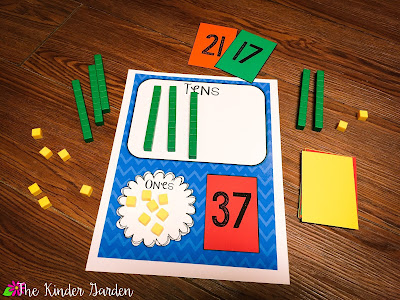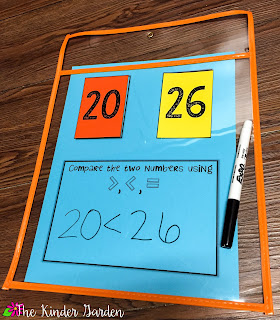This past school year was my first one teaching first grade, and with that came a whole new set of standards that I had never taught before, including place value in math! In my district, they dive right in to place value in the first part of the school year; and it was so difficult for my new first graders to understand all of the concepts. It was so important for me to give them hands-on, meaningful activities to work with learning all of the basics of place value and I want to share a few of them with you today!
One of the first things I wanted my students to understand was the meaning of tens and ones. They could tell me the name of a number, but did they really understand how it was made?
One easy strategy I implemented during calendar time was asking them what we needed to make a certain number. I'd ask them, "How do we make the number 23?" And they'd answer "2 groups of 10 and 3 ones left over. It was important to get them to use the math vocabulary when describing the number. That helped them begin to understand what each place represented in the number.
Then, we set about building numbers with hands-on manipulatives. Here's the beauty of place value - you do not have to have place value blocks to teach kids how to build numbers! When I first got to my new classroom, I had no math manipulatives - zero! The previous teacher in my room had taken them all when she moved to a new school. So, until I could get some official math resources of my own, I had to use a few unconventional hands-on resources. Trust me, your students won't mind! In fact, they love when they get to use something new in the classroom!
To help my students understand the difference between tens and ones, I had them start by just creating separate groups of ten. I put two giant whiteboards on the rug and wrote the number 10 on them to let the kids know that only 10 was allowed to go on the board - no more, no less!
I wanted something big enough to see on the large boards, so enter unconventional manipulative #1: pointers! I gave 20 pointers to various students and we sorted them by tens. Once we were done, we skip counted by 10 to see how many we had and then practiced writing the numbers we created.
Another unconventional place value manipulative we used often was beans (bought a bag for less than a dollar at the grocery store!). I gave each table group a bucket of beans and a stack of Dixie cups. They had to create groups of tens by filling each cup with 10 beans until they were completely gone from the bucket. Then we counted to see how many groups of ten we had! They were amazed at how many cups they were able to fill to make ten.
Another unconventional place value manipulative we loved to use was unifix cubes! To continue practice making groups of ten, I gave each student a pile of cubes and they used their desks as a whiteboard to count and circle each group of ten they had.
Once my students had a stronger grasp on tens, we moved to ones and began building whole double digit numbers in various hands-on ways.
Once my students were able to work more independently on these concepts, I started putting some of these activities into independent or small group math stations. One of our favorite activities was using card games and place value mats!
Students use these build-a-number mats by choosing a number card, placing it on the mat, and building the number with tens and ones.
With these printable mats, students identify how many groups of ten or how many ones are in a given number.
My students became much more confident in their skills... it was so exciting for me as a teacher! Then we built upon our skills with comparing numbers using greater than, less than, or equal to.
Later on in the year, we paired up our knowledge of place value with addition and subtraction. We started by learning how to identify ten more and ten less than a given number, which I blogged about here! My students loved filling out these tens ladders with giant whiteboards.
And we used these write-on/wipe-off mats in math stations.
With these addition and subtraction mats, students choose two number cards, place them on the mat, and then build and write the number sentence to solve the answer.
Most of these activities can be found in my Place Value Activity Mats pack on TPT! Just click the picture below to go to the product. Both full color and black and white versions are included for each activity mat!





























